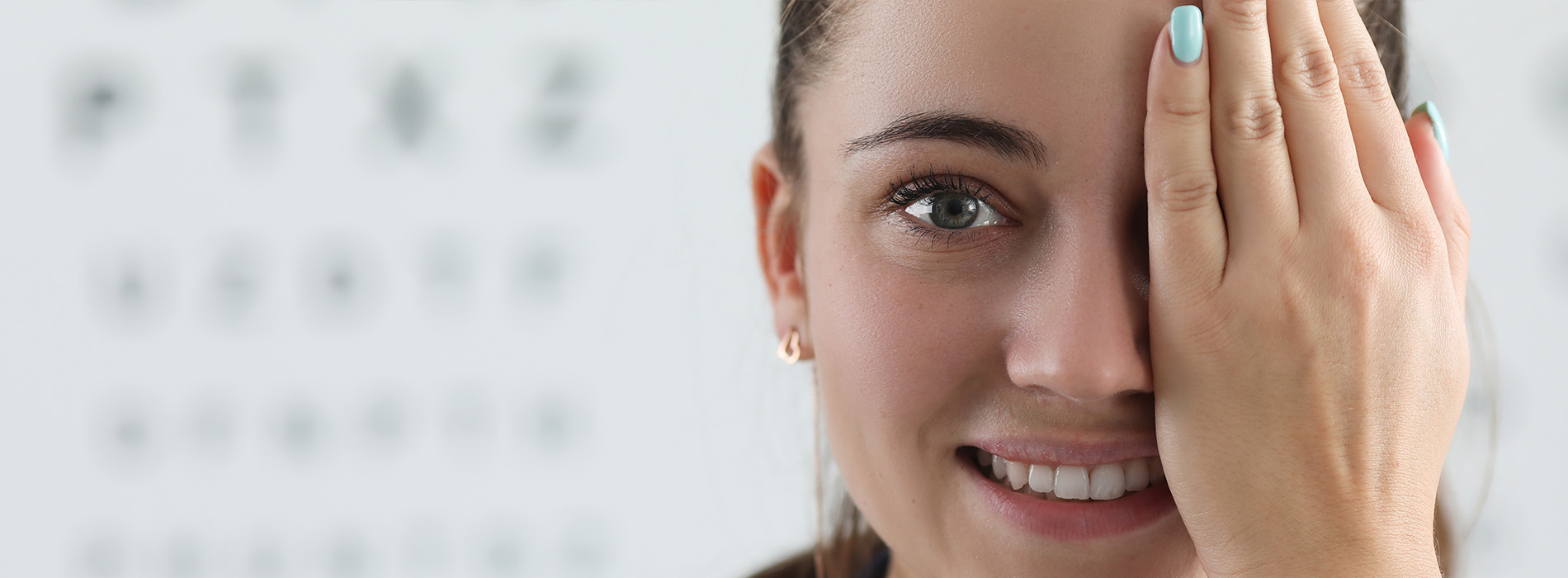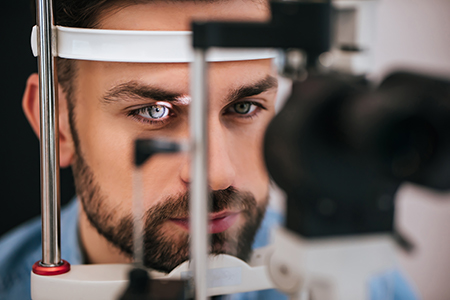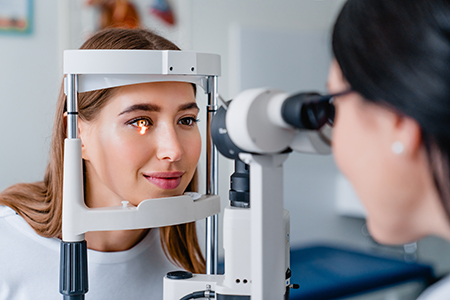
Clear vision shapes how we work, connect, and enjoy life. A comprehensive eye exam is more than a prescription check — it’s a detailed health assessment that looks at the whole visual system and the tissues that support it. Making these exams part of your routine helps catch small problems before they become large ones and keeps your eyesight reliable as your lifestyle changes.
At Vision World of Copiague, our approach blends proven clinical methods with modern imaging and diagnostic tools so every exam is thorough and personalized. We evaluate your visual needs, screen for early signs of disease, and review any systemic health clues the eyes may reveal. The goal is not only clear sight but also long-term eye health and comfort.
Children, adults, and older adults all benefit from an exam tailored to their stage of life. Vision develops rapidly in early childhood and can change significantly with age or health conditions. Routine, stage-appropriate care supports learning, driving safety, work productivity, and overall quality of life.
Scheduling periodic comprehensive exams gives you a stable baseline for comparison over time and ensures timely intervention when a change is detected. Our team focuses on clear explanations and a relaxed, professional atmosphere so you feel informed and comfortable throughout the process.
Many people think of an eye exam only when vision blurs. In reality, a comprehensive eye exam assesses visual function and the structures of the eye, often revealing issues long before they affect daily tasks. Early detection of problems like glaucoma or retinal changes greatly improves the effectiveness of treatment and monitoring.
Comprehensive exams also evaluate how your eyes work together, your focusing ability, and how well you perceive depth and color — all elements that influence safety and performance at work, school, and on the road. A thorough evaluation helps match the right vision correction or therapy to your life.
Because the eye is uniquely connected to overall health, an exam can uncover signals of broader medical concerns. High blood pressure, diabetes, and certain neurological conditions can produce changes visible to an eye care professional. Identifying these signs supports coordinated care between your eye doctor and your primary care providers.
Our practice emphasizes prevention and continuity. By establishing an individualized exam schedule and keeping detailed records, we can spot subtle trends and make recommendations that preserve vision and maximize comfort over the years.

A comprehensive exam is a sequence of painless tests designed to evaluate vision and the health of the eye. Typical visits include a review of your medical and family history, discussion about your visual demands, and a series of diagnostic procedures. Most patients find the process straightforward and leave with a clear understanding of their results.
Expect the visit to last long enough for careful testing and a discussion with the doctor — often up to an hour. That time allows for objective measurements, hands-on assessments, and any imaging needed to record the appearance of the retina and optic nerve for future comparison.
Many of the tests are quick and noninvasive. During the exam we check acuity, eye alignment and movement, pupil response, corneal curvature, and the pressure inside the eye. If indicated, we dilate the pupils to obtain an unobstructed view of the retina and optic nerve — a step that enhances our ability to detect early disease.
A typical set of tests performed during a comprehensive exam may include:
Visual acuity testing – Measures how clearly you see at various distances and establishes a baseline for any corrective lenses.
Color vision screening – Detects inherited color perception issues and flags certain retinal or optic nerve conditions that can affect color discrimination.
Stereopsis and depth perception – Assesses how effectively the two eyes work together to interpret three-dimensional space.
Ocular motility testing – Evaluates the eye muscles and coordination as your eyes follow moving objects or shift focus between targets.
Pupil response testing – Looks at how pupils react to light and accommodation, which can suggest neurological or ocular issues.
Autorefraction – A computerized estimate of your prescription that speeds the refraction process while informing the clinician’s judgment.
Retinoscopy – Uses reflected light to help estimate the lens power your eyes need when subjective testing is difficult or inconsistent.
Refraction – Refines your prescription using your responses to lens changes so you get the most accurate correction for glasses or contacts.
Keratometry – Measures the curvature of the cornea, important for fitting contact lenses and detecting irregular corneal shapes.
Slit-lamp examination – A high-magnification look at the front and back structures of the eye to evaluate clarity, inflammation, and early disease signs.
Peripheral visual field testing – Screens for blind spots or field loss that can indicate retinal or optic nerve problems.
Intraocular pressure measurement – A key screen for glaucoma risk that helps guide further evaluation or monitoring.
Pupil dilation – When performed, dilation gives a more complete view of the retina and optic nerve and is particularly useful for patients at higher risk of retinal disease.
Please note: dilating drops take about 20 minutes to take effect, and you may experience light sensitivity for a few hours. Sunglasses or a ride home are often recommended after dilation.
When additional information is needed, we may use retinal photography, optical coherence tomography (OCT), corneal topography, or automated visual fields. These tools offer precise, repeatable records that improve our ability to track changes over time and customize treatment plans.
Our clinicians take time to explain findings and recommend a follow-up schedule tailored to your risk factors and visual needs. Whether prescribing glasses, fitting contact lenses, or coordinating care with medical specialists, the focus is always on preserving function and comfort.

Refractive errors are extremely common and are responsible for most forms of correctable vision impairment. They occur when light does not land precisely on the retina, producing blurry or distorted vision. Simple, reliable corrections often restore clear sight and reduce symptoms such as headaches or eye strain.
Because refractive errors can develop or change over time, regular measurement is important. A small shift in prescription may make tasks like reading, driving, or screen work more difficult and less comfortable. Timely correction helps maintain productivity and visual comfort.
Beyond clarity, correcting refractive errors can improve visual performance for sports, occupational tasks, and hobbies. The right solution — glasses, contacts, or a referral for a surgical option when appropriate — depends on your lifestyle, health, and personal preferences.
Myopia (nearsightedness) – Objects at a distance appear fuzzy while near tasks remain relatively clear; often develops in childhood and can progress during growth years.
Hyperopia (farsightedness) – Difficulty focusing on near objects; younger eyes often compensate, but symptoms may emerge with prolonged near work or as the eye ages.
Astigmatism – Irregular curvature of the cornea or lens causes distortion at all distances and may accompany other refractive conditions.
Presbyopia – An age-related change in lens flexibility that reduces near focusing ability, commonly becoming noticeable in the 40s and beyond.

Identifying a refractive error or an eye condition is the starting point for a targeted plan. For many patients, the next steps are straightforward: a precise prescription for eyeglasses or a contact lens fitting to match visual needs and comfort. We explain the pros and cons of each option so you can make an informed choice.
In situations that require medical or surgical care, we coordinate referrals and make evidence-based recommendations. For chronic conditions like glaucoma or macular degeneration, regular monitoring and timely treatment decisions are key to preserving sight.
We also advise on lifestyle adjustments and protective strategies — blue light considerations, ergonomic tips for screen use, UV protection for outdoor activities, and dry eye management — all practical measures that support comfort and visual health.
Age brings natural changes to the eye, and the risk of certain diseases rises with it. Regular exams become increasingly important because many age-related conditions show little early discomfort. Detecting cataracts, glaucoma, macular degeneration, or diabetic changes at an early stage improves management options and outcomes.
A baseline exam around middle age establishes a reference for future comparisons. From that point, the exam frequency is personalized based on your health, family history, and any symptoms. Our clinicians monitor trends and recommend interventions that preserve independence and quality of life as you get older.
Preventative measures like controlling systemic conditions, wearing protective eyewear, and following a tailored screening plan help reduce the risk of vision-threatening changes. We work with each patient to build a clear, manageable plan for ongoing care.

Early eye care sets the foundation for learning, coordination, and social development. Children’s vision changes quickly during the first years of life, and early problems — when treated — respond best. A child-friendly exam checks not just how well a child sees but how their visual system supports reading, tracking, and classroom performance.
Pediatric assessments are adapted to each age and stage, using techniques that are comfortable and engaging for young patients. When vision issues are found, interventions may include glasses, patching for amblyopia (lazy eye), or vision therapy to improve binocular function.
Following professional guidelines, we recommend early and periodic exams to track development and address concerns as they arise. Our team strives to make visits relaxed and informative so families feel confident about their child’s visual progress.
Children should receive an eye exam in infancy, again before school entry, and routinely through their school years. The exact schedule may be adjusted when risk factors are present.
In every exam, our team aims to give clear recommendations, practical next steps, and a plan for follow-up that fits your life. If you’d like to learn more about comprehensive eye exams or when to schedule one, please contact us for additional information.
Even if your vision is 20/20, it’s essential to keep in mind that everyone requires a comprehensive eye exam periodically. Nonetheless, how often you or a member of your family should have one depends on several factors. A patient’s age, family and personal medical histories, a previous eye injury, existing eye conditions, and environmental or occupational factors influence the recommended frequency.
The American Optometric Association offers the following guidelines:
Children – Children should receive an eye exam at between 6 months to 12 months of age, once between the ages of 3 and five, before entering first grade and then annually thereafter. However, in the presence of certain risk factors or diagnosed vision issues and impairments, the recommended exam schedule may differ.
Adults – In the absence of risk factors, adults between the ages of 18 to 39 years should schedule an eye exam at least once every two years. Because several eye diseases can develop with age, a baseline eye exam is recommended at the age of 40. A patient’s risk factors determine the recommended schedule between the ages of 40 and 64 years. At-risk adults over 40 may require annual or more frequent eye exams. For low-risk adults, the eye doctor may determine that an exam every two years may suffice. For adults 65 and older, annual exams are recommended.
It’s essential to remember to bring your current eyeglasses or contact lenses prescription to your visit. If you also wear reading glasses, computer glasses, protective eyewear, or other visual aids, you may want to bring these as well. Because getting your pupils dilated can leave you sensitive to light for several hours following your appointment, it’s wise to bring sunglasses to the appointment.
In addition to your medical and eye health history, you will be asked about your family’s eye health history and any contributing factors that may increase your risk of eye disease. As best you can, be prepared with this information. It’s also helpful to have a comprehensive list of any medications that you are taking. Remember to bring your medical insurance and vision insurance card and information along to your visit.
If you have questions or concerns about your eye health and vision, an eye exam visit offers an excellent opportunity to discuss what's on your mind and get helpful eye care tips and guidance.
It’s essential to keep in mind that vision screenings take a very basic look at your eyesight and are not used to diagnose or treat vision problems. They are designed to merely detect them and are often performed by a school nurse or pediatrician. While a vision screening may be useful in identifying a vision impairment that requires further care, it is by no means a substitute for a comprehensive eye exam. As a rule, the only way to precisely detect and diagnose any vision abnormalities or identify the presence of eye disease is through a comprehensive and in-person eye exam.
If you have vision insurance, you can expect to have coverage for some aspects of care. While every vision plan offers specific benefits, they generally offer some coverage for routine care such as annual exams and eyewear. If your eye condition qualifies as a medical issue, some coverage under your medical insurance may apply. At the office of Vision World of Copiague, we strive to optimize your insurance benefits and minimize your out-of-pocket expenses. Although our financial office is well versed in the complexities of insurance coverage, it’s always a good idea to review your specific benefits with your HR department or insurance carrier.
At the office of Vision World of Copiague, we welcome patients of all ages and offer a comprehensive range of vision care services and products to help every member of your family protect the health of their eyes and enjoy optimal sight. We use the most advanced technology and proven treatment methods to deliver precise, gentle, and effective care. Whether you or any member of your family require an eye exam, prescription lenses, protective eyewear, contacts, and hard-to-fit contact lenses to pre and post-LASIK care or other eye care services, we’re well equipped to help.
For more information on our office and the many services we provide, give us a call today.
A comprehensive eye exam is a complete evaluation of your visual system and the overall health of your eyes. It goes beyond a basic vision screening to measure refractive error, assess eye alignment and movement, and examine the internal and external structures of the eye. The goal is to identify vision problems and detect early signs of eye disease before they progress.
During the exam, an eye doctor will perform a variety of tests such as refraction, slit-lamp evaluation, intraocular pressure measurement, and retinal assessment. Advanced retinal imaging and diagnostic tools are often used to capture detailed views of the retina and optic nerve. At Vision World of Copiague, we combine clinical expertise with modern technology to ensure a thorough and accurate assessment of your eye health.
Frequency of comprehensive eye exams varies by age, health status, and risk factors. Adults under 40 with no symptoms and no risk factors typically benefit from exams every two years, while those over 40 or with risk factors should be seen more often. Children, seniors, and people with diabetes or a family history of eye disease generally require more frequent monitoring.
If you experience changes in vision, persistent eye discomfort, or new symptoms, you should schedule an exam regardless of your last visit. Your eye doctor will recommend an individualized follow-up plan based on findings and overall health. Establishing a regular exam schedule helps detect conditions early when treatment is most effective.
A comprehensive exam typically includes a series of diagnostic tests to evaluate both vision and eye health. Common assessments include visual acuity testing, computerized autorefraction, manual refraction to determine prescription, slit-lamp examination to view anterior structures, measurement of intraocular pressure, and dilated fundus examination or retinal imaging. Additional tests may assess color vision, depth perception, peripheral visual fields, and eye muscle function.
These tests work together to reveal refractive errors, early signs of glaucoma, macular degeneration, diabetic changes, and other ocular conditions. Modern imaging devices can capture high-resolution photos and scans that are saved for comparison over time. The results guide recommendations for corrective lenses, medical management, or referral when specialized care is needed.
Pupil dilation involves using eye drops to widen the pupil so the doctor can examine the retina and optic nerve more thoroughly. Dilation provides a clearer, wider view of the back of the eye, which helps detect retinal tears, diabetic retinopathy, macular degeneration, and other conditions that may not be visible with an undilated exam. It is a safe and common part of comprehensive eye care when indicated.
Dilating drops typically take about 15 to 30 minutes to take effect and can cause light sensitivity and blurred near vision for a few hours afterward. Patients are advised to bring sunglasses and, if needed, arrange for transportation if driving is difficult shortly after the exam. Your doctor will discuss the benefits of dilation and whether it is recommended for your visit.
The eyes offer a unique window into overall health because blood vessels and nerve tissues are visible without invasive procedures. During a comprehensive exam, changes in the retina or blood vessels can reveal signs of systemic conditions such as diabetes, hypertension, high cholesterol, and certain autoimmune or neurological diseases. Detecting these signs early enables timely communication with your primary care provider for further evaluation.
Retinal imaging and careful examination can show vascular narrowing, hemorrhages, or swelling that correlate with systemic disorders. When such findings are present, the eye doctor will document the observations and recommend appropriate medical follow-up and monitoring. Early detection through eye care can play a critical role in preserving both vision and general health.
Pediatric eye exams are tailored to a child's developmental stage and use age-appropriate testing methods to assess visual function. Exams for infants and young children may focus on tracking, fixation, and eye alignment, while older children receive visual acuity testing, binocular vision assessment, and screenings for refractive errors and amblyopia. Early and regular exams help ensure vision development proceeds on schedule and support learning and motor skills.
Guidelines recommend an initial pediatric eye assessment during infancy, another exam between ages three and five, and again before starting school, with routine checks thereafter as advised. Tests are often adapted to make the visit comfortable and engaging for children, and recommendations can include eyeglasses, vision therapy, or referrals when needed. Vision World of Copiague provides child-focused exams that emphasize accurate diagnosis and a positive experience for young patients.
A routine comprehensive exam identifies refractive error and overall eye health, but a contact lens fitting requires additional specialized measurements and assessments. A contact lens evaluation includes precise keratometry or corneal topography to measure the curvature of the cornea, assessment of the tear film and eyelid function, and trial fitting to determine the appropriate lens type, material, and fit. These steps ensure both comfort and safe lens wear.
If you are interested in contact lenses, your eye doctor will explain the differences between lens types and whether you are a good candidate based on your prescription, corneal shape, and ocular surface health. Follow-up visits are important to monitor fit, vision, and eye health, particularly during the initial adaptation period. Proper instruction on lens care and wear schedules is provided to reduce the risk of complications.
Most comprehensive eye exams take about 45 minutes to an hour, depending on the number of tests performed and whether dilation or advanced imaging is needed. Complex cases, a thorough medical history review, or additional diagnostic testing can extend the visit. Expect to discuss your general health, medications, work and lifestyle factors, and any visual symptoms during the appointment.
To prepare, bring your current glasses or contact lenses, a list of medications and relevant medical history, and any questions you want to address. Contact lens wearers may be asked to remove lenses before certain tests, so following pre-appointment instructions is helpful. Bringing sunglasses and arranging transport after dilation can also make your visit more comfortable.
The most common refractive errors are myopia (nearsightedness), hyperopia (farsightedness), astigmatism, and presbyopia. Myopia causes distant objects to appear blurred, hyperopia makes near tasks more difficult, astigmatism results from an irregular corneal shape that distorts vision, and presbyopia is an age-related loss of near focusing. Each condition affects how light is focused on the retina and can be accurately measured during a comprehensive exam.
Correction options include prescription eyeglasses, contact lenses, and refractive surgery when appropriate and feasible. Your eye doctor will determine the exact prescription through refraction and discuss which correction best matches your visual needs, lifestyle, and ocular health. Regular follow-up ensures prescriptions remain current and that corrective options continue to provide safe, clear vision.
Certain symptoms warrant prompt evaluation rather than waiting for a routine visit, including sudden vision loss, new flashes of light, a sudden increase in floaters, severe eye pain, or a significant change in vision. Other concerning signs include persistent double vision, eye redness with pain or discharge, and sudden onset of a dark shadow or curtain across your field of vision. These symptoms can indicate urgent conditions that require immediate attention.
If you experience any of these warning signs, contact your eye care provider right away to arrange an expedited exam or referral to a specialist. Timely assessment can make a critical difference in outcomes for conditions such as retinal detachment, acute glaucoma, or severe infections. When in doubt, seeking prompt evaluation is the safest course for protecting your sight.
Quick Links
Contact Us